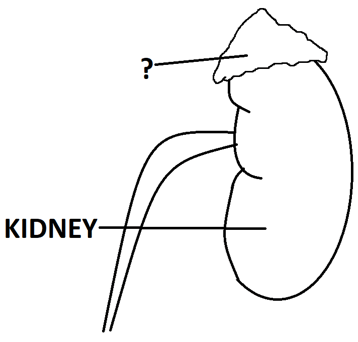This set of Class 11 Biology Chapter 22 Multiple Choice Questions & Answers (MCQs) focuses on “Chemical Control and Coordination – Human Endocrine System – 3”.
1. Which of these is not a function of thyroid hormones?
a) Regulation of basal metabolic rate
b) Erythropoiesis
c) Maintenance of electrolyte balance
d) Regulation of diurnal cycle
View Answer
Explanation: Thyroid hormones are important for the regulation of basal metabolic rate. It also helps erythropoiesis and maintains water and electrolyte balance. However, the pineal gland regulates the diurnal cycle.
2. TCT is secreted by the ______
a) hypothalamus
b) pituitary gland
c) thyroid gland
d) adrenal cortex
View Answer
Explanation: TCT or thyrocalcitonin is secreted by the thyroid gland, along with thyroxine and triiodothyronine. The function of thyrocalcitonin is to regulate the blood calcium level. Thyrocalcitonin is a protein hormone.
3. How many parathyroid glands do humans possess?
a) 2
b) 3
c) 4
d) 1
View Answer
Explanation: Humans possess 4 parathyroid glands. They are present on the back side of the thyroid glands. The thyroid gland has two lobes. Each lobe of the thyroid gland contains one pair of parathyroid glands.
4. Which of these is not a function of PTH?
a) Reduces calcium ion reabsorption from digested food
b) Increases calcium ion level in blood
c) Stimulates demineralization
d) Stimulates reabsorption of calcium ions in kidneys
View Answer
Explanation: PTH or parathyroid hormone is secreted by the parathyroid gland. It is important for regulating the blood calcium level along with thyrocalcitonin. PTH increases calcium ion absorption from digested food.
5. What is the shape of the thymus gland?
a) Spherical
b) Lobular
c) Irregular
d) Triangular
View Answer
Explanation: The thymus gland is lobular in shape. It is an important lymphatic organ. The thymus is situated behind the sternum and between the lungs. It secretes thymosin which is a peptide hormone.
6. Which of these statements is false about thymus?
a) Differentiation of T-lymphocytes take place here
b) It secretes thymosin
c) It is intact for persons of all ages
d) Promotes production of antibodies
View Answer
Explanation: Thymus is an endocrine gland situated between the lungs and behind the sternum. It secretes thymosin and the differentiation of T-lymphocytes takes place here. It promotes antibody production. However, the thymus degenerates in old individuals.
7. Where are the adrenal glands located?
a) Above the kidneys
b) Between the lungs
c) Around the trachea
d) Base of the hypothalamus
View Answer
Explanation: The adrenal glands are located just above the kidneys. It is pyramidal in shape. The thyroid gland is located around the trachea, the thymus is located between the lungs and the pituitary gland is located at the base of the hypothalamus.
8. Identify the structure in the given below.

a) Pineal gland
b) Thymus
c) Parathyroid gland
d) Adrenal gland
View Answer
Explanation: The given picture shows a kidney with a pyramidal structure above it. This is the adrenal gland which is an endocrine gland. The adrenal gland is divided into two parts- the outer cortex and the inner medulla.
9. What is the disease caused by the deficiency of adrenal cortex hormones?
a) Acromegaly
b) Graves’ disease
c) Addison’s disease
d) Diabetes Insipidus
View Answer
Explanation: The deficiency or underproduction of hormones of the cortex of the adrenal gland leads to Addison’s disease. It is characterized by fatigue and weakness due to an alteration in carbohydrate metabolism.
10. T-lymphocytes provide cell-mediated immunity. True or false?
a) True
b) False
View Answer
Explanation: T-lymphocytes are produced by the thymus, which is an endocrine gland and an important organ of the lymphatic system. The differentiation of T-lymphocytes occurs here. They provide cell-mediated immunity.
11. Catecholamines are secreted by the ______
a) posterior pituitary
b) anterior pituitary
c) adrenal cortex
d) adrenal medulla
View Answer
Explanation: Catecholamines are secreted by the adrenal medulla, which is the inner part of the adrenal gland lying below the adrenal cortex. The catecholamines include the hormones adrenaline and noradrenaline.
12. Which of these hormones would be rapidly secreted in a man if he was being chased by a dog?
a) Somatostatin
b) Somatotropin
c) Epinephrine
d) Prolactin
View Answer
Explanation: Epinephrine or adrenaline is an emergency hormone that is rapidly secreted during stressful or emergency situations, such as when a man is being chased by a dog. It is secreted by the adrenal cortex.
13. Which of these is not an effect of catecholamine secretion?
a) Piloerection
b) Pupillary dilation
c) Glycogen formation
d) Increase in heart rate
View Answer
Explanation: Catecholamines are emergency hormones which are secreted during stressful situations by the adrenal cortex. They cause the breakdown of glycogen to glucose, which raises the blood sugar level.
14. Which of these substances does norepinephrine not stimulate the breakdown of?
a) Glucose
b) Lipids
c) Proteins
d) Glycogen
View Answer
Explanation: Norepinephrine is a catecholamine or an emergency hormone. It is secreted during stressful situations. Glycogen, lipids and proteins are broken down to raise the blood glucose level. It does not stimulate glucose breakdown.
15. What is the name of the outer layer of the adrenal cortex?
a) Zona reticularis
b) Zona glomerulosa
c) Zona fasciculata
d) Zona pellucida
View Answer
Explanation: The adrenal cortex is divided into three parts-the inner layer or the zona reticularis, the middle layer or the zona fasciculata and the outer layer or the zona glomerulosa. Zona pellucida is a covering that surrounds the ovum in females.
Sanfoundry Global Education & Learning Series – Biology – Class 11.
To practice all chapters and topics of class 11 Biology, here is complete set of 1000+ Multiple Choice Questions and Answers.
If you find a mistake in question / option / answer, kindly take a screenshot and email to [email protected]
- Check Class 11 - Books
- Practice Class 11 - Chemistry MCQs
- Practice Class 11 - Mathematics MCQs
- Practice Class 11 - Physics MCQs
- Practice Class 12 - Biology MCQs
